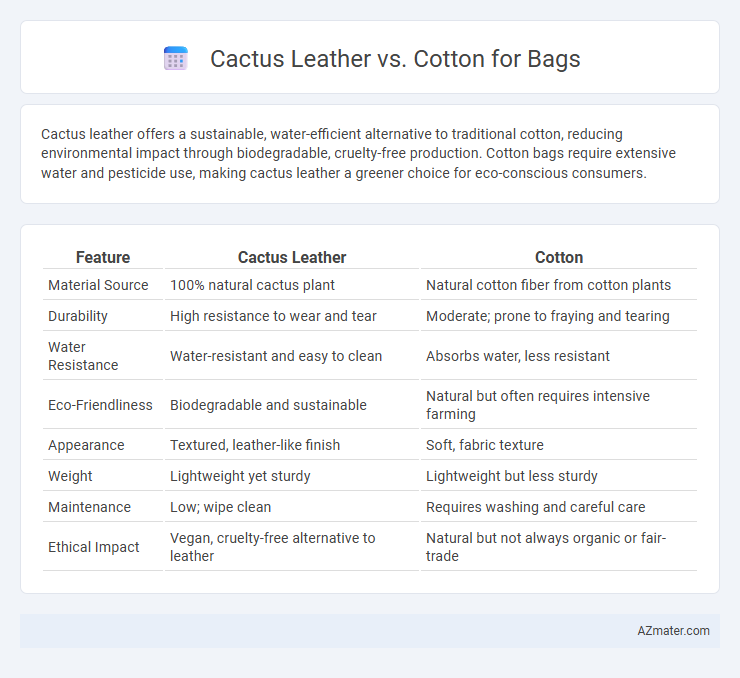Cactus leather offers a sustainable, water-efficient alternative to traditional cotton, reducing environmental impact through biodegradable, cruelty-free production. Cotton bags require extensive water and pesticide use, making cactus leather a greener choice for eco-conscious consumers.
Table of Comparison
| Feature | Cactus Leather | Cotton |
|---|---|---|
| Material Source | 100% natural cactus plant | Natural cotton fiber from cotton plants |
| Durability | High resistance to wear and tear | Moderate; prone to fraying and tearing |
| Water Resistance | Water-resistant and easy to clean | Absorbs water, less resistant |
| Eco-Friendliness | Biodegradable and sustainable | Natural but often requires intensive farming |
| Appearance | Textured, leather-like finish | Soft, fabric texture |
| Weight | Lightweight yet sturdy | Lightweight but less sturdy |
| Maintenance | Low; wipe clean | Requires washing and careful care |
| Ethical Impact | Vegan, cruelty-free alternative to leather | Natural but not always organic or fair-trade |
Introduction: Cactus Leather vs Cotton for Bags
Cactus leather offers a sustainable and eco-friendly alternative to traditional cotton for bags, boasting durability and water resistance without the environmental impact of conventional leather. Cotton, while natural and breathable, often involves intensive water and pesticide use, making it less sustainable in large-scale production. Choosing cactus leather supports innovation in plant-based materials that reduce carbon footprint and resource consumption.
Material Origins and Production Processes
Cactus leather originates from the mature leaves of the nopal cactus, harvested sustainably in arid regions like Mexico, and processed by drying, milling, and combining with non-toxic natural polymers to create a durable, eco-friendly alternative to animal leather. Cotton for bags is derived from the cotton fibers surrounding the seeds of the Gossypium plant, primarily grown in warm climates such as the United States, India, and China, with production involving harvesting, ginning, spinning, and weaving into fabric. While cactus leather production emphasizes water conservation and low environmental impact, conventional cotton cultivation often requires significant water, pesticides, and synthetic fertilizers, influencing the sustainability profiles of both materials.
Environmental Impact Comparison
Cactus leather significantly reduces environmental impact compared to cotton by requiring up to 95% less water and producing fewer greenhouse gas emissions during cultivation and processing. Unlike cotton farming, which often involves intensive pesticide use and soil degradation, cactus leather is derived from sustainable, low-impact harvesting of mature cactus plants that regenerate naturally. The biodegradability and lower resource demands of cactus leather make it a more eco-friendly choice for bags, promoting circular fashion and reducing overall carbon footprint.
Durability and Longevity
Cactus leather offers superior durability compared to cotton, featuring high resistance to wear, scratches, and water damage, which extends the lifespan of bags made from this material. Unlike cotton, which tends to fray and degrade faster under regular use, cactus leather maintains its structural integrity and aesthetic appeal over time. This makes cactus leather an ideal, sustainable choice for bags requiring long-lasting performance and minimal maintenance.
Aesthetic and Design Versatility
Cactus leather offers a sleek, matte finish with a natural grain that enhances modern and minimalist bag designs, providing a unique texture not found in traditional fabrics. Cotton, while softer and more breathable, tends to show wear and stains more easily, limiting its longevity in high-usage bags and reducing design versatility. The inherent durability and eco-friendly appeal of cactus leather make it a preferred choice for stylish, long-lasting bags with diverse aesthetic possibilities.
Comfort and Usability
Cactus leather offers a soft, flexible texture that enhances bag comfort by adapting to the user's shape, while cotton bags provide breathability but lack the durability and structure for long-term use. The natural water resistance and lightweight nature of cactus leather improve usability by protecting contents and reducing fatigue during extended wear. Cotton bags excel in easy maintenance and eco-friendliness but may absorb moisture and wear down faster, diminishing overall comfort and practicality.
Maintenance and Care Requirements
Cactus leather requires minimal maintenance, needing only occasional wiping with a damp cloth to remove dirt and prevent buildup, making it highly durable and water-resistant compared to cotton. Cotton bags demand more frequent cleaning, often requiring machine washing or spot cleaning due to their absorbent nature, which can lead to faster wear and fading. The moisture resistance and easy upkeep of cactus leather contribute to its longevity and make it a superior choice for users seeking hassle-free bag care.
Cost and Market Availability
Cactus leather typically costs more than cotton due to its sustainable production process and innovative technology, positioning it as a premium material in the bag market. Cotton remains widely available and affordable, benefiting from established supply chains and large-scale cultivation worldwide. Market availability of cactus leather is growing but still limited compared to the extensive cotton market, impacting its accessibility for mass-produced bags.
Consumer Trends and Preferences
Cactus leather is gaining popularity among eco-conscious consumers seeking sustainable alternatives to traditional materials, driven by its biodegradable properties and lower environmental impact compared to cotton cultivation, which demands high water and pesticide use. Consumers also show growing interest in vegan leather options like cactus leather due to increased awareness of animal welfare and ethical fashion. Despite cotton's breathability and familiarity, market preferences are shifting towards innovative, plant-based materials that align with zero-waste and carbon footprint reduction values.
Which Material Wins for Eco-Friendly Bags?
Cactus leather outperforms cotton in eco-friendly bags by requiring significantly less water and land during production, making it a sustainable alternative to traditional cotton, which demands extensive agricultural resources and pesticides. The durability of cactus leather also extends the lifespan of bags, reducing waste compared to cotton, which tends to wear out faster. With lower carbon emissions and biodegradable properties, cactus leather proves to be the superior choice for environmentally conscious consumers seeking sustainable bag materials.

Infographic: Cactus leather vs Cotton for Bag
 azmater.com
azmater.com